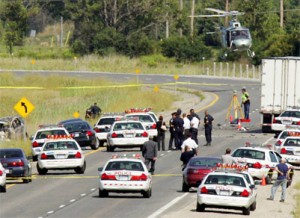Twenty-five years after Ontario introduced its independent police oversight unit, Ralph Agard — who helped push for the unit in 1989 — is satisfied with what it’s done, but many others who’ve been watching closely aren’t as convinced.
The Special Investigations Unit, often referred to as the SIU, is an independent unit which looks at any serious civilian injury, death or sexual assault involving police officers in Ontario.
The unit was introduced in 1990 to address misconduct and regain public confidence, particularly after a series of police shootings against black men in Toronto.
The SIU was inspired by a recommendation in the 1989 Clare Lewis report. Ralph Agard was a member of the original task force that wrote the report.
At the time, tensions were high between the black community and the Toronto police force.
“There were protests and marches….I remember stepping out of a coffee shop and you could cut the tension with a knife,” Agard says.
He says it’s not the same today, and he believes the SIU has been “an instrument of change.”
Not everyone agrees with that success story, though. At least not entirely.
In the early years of the SIU, high expectations were met with disappointment. The unit had a lack of legislation, limited resources and high turnover at the director level. This continued for quite a few years.
In 2008, the Ombudsman of Ontario — also a former director of the SIU — released a report which compared the SIU to a “toothless tiger.”
He found that the unit was “under-resourced, slow to respond to calls, and soft on police services that failed to follow the rules.”
Every year, the amount of SIU cases continue to increase — but relatively few charges have been laid. In their 2012-2013 fiscal year, 3.8% of cases resulted in charges.
According to Doug Hatlem, who recently produced a documentary about police brutality in Toronto, the number of officers actually charged by the SIU is “atrocious.”
Peter Rosenthal — the lawyer who represented police-shooting victim Sammy Yatim’s family — says Yatim’s case was unique. Massive public outcry spurred from the viral spreading of a video of the last few minutes of Yatim’s life in 2013. James Forcillo, the officer who shot Yatim on a streetcar in Toronto, was later charged with second-degree murder. Most cases don’t end that way, Rosenthal says.
But Agard warns against judging the effectiveness of the SIU based solely on the number of charges laid — as there’s nothing to say the cleared officers weren’t all innocent.

But there’s still a lack of trust in the system.
Hatlem says that, although none of the investigators at the SIU are currently police officers, the majority of them used to be— mostly because they’re experienced in criminal investigations. But “there is a sense of camaraderie that doesn’t really disappear,” he says.
Two years ago, the Independent Investigations Office of B.C., a similar police oversight unit, began moving towards full civilian staffing — and Hatlem argues that Ontario should be doing the same thing.
“The more independent something is, the more confidence the people have in the conclusions,” says Michael Kempa, a criminology professor at the University of Ottawa.
Additionally, the antagonistic relationship between the SIU and the police force has been a struggle since the start.
The Ombudsman’s 2011 review of the SIU revealed that the unit had experienced everything from passive non-compliance to outright lack of cooperation from the police force. According to the report, they had been denied access to crime scenes and weren’t always immediately notified of incidents.
Jasbir Dhillon, a spokesperson for the SIU, says the unit has also had problems with officers hiring lawyers to help write their reports.
In 2014, the Supreme Court decided that police must make duty notes for the SIU independently — without a lawyer or other officers. Dhillon says this decision will help ensure that the reports show a more truthful account of what happened.
Dhillon says the SIU’s been making slow but consistent progress since 1990, and Kempa says they’ve shown “promising signs” in recent years.
The legislation that the SIU relies on was recently toughened, which helped give them more power, but many criminology experts agree that they still need more if they’re going to be effective. “More needs to be done,” says Hatlem.


